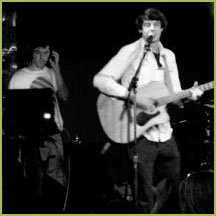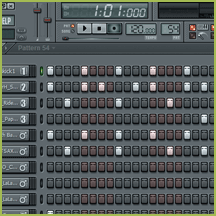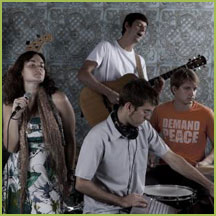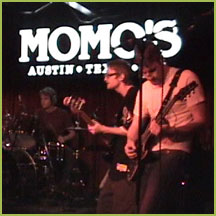Soundscape Jukebox
The Pepper Lane soundscape features three audio tracks: "Can't Freeze Time," "Glass Homes," and "Floodgates." Listen to each via the music player above. The three songs featured here are digital soundscapes, designed to accompany the band, Pepper Lane, performing the following additional instruments: rhythm guitar, lead guitar, drumkit, bass, and voice.

select above to view the complete image, or click here

select above to view the complete image, or click here

select above to view the complete image, or click here

select above to view the complete image, or click here

select above to view the complete image, or click here
10/28/09 Cabe Lindsay's Soundscapes Project 02
Pepper Lane
In this elaborate learning experience, I discovered how to arrange music for a group and perform as a member of a group. I transitioned from a folk singer-songwriter to an electronic DJ. I invested 100+ hours into writing new music, rehearsing, and performing with a band, all over the course of just one month. My efforts were presented on stage at a concert in downtown Austin, Texas on October 9, 2009.
What Did I Make?
The result of all my efforts is a three-tier personal learning experience, two of which are available to share:
1. I made a series of original soundscapes, and the following MP3s are available: Can't Freeze Time, Glass Homes, and Floodgates (right-click or control-click to download).
2. I made original music performed live in concert, as documented by this video: Can't Freeze Time.
3. I made new folds in my brain as the result of experiencing new things. Yes, these are real "things I made," and I expressed this through an in-class demonstration of what I learned.
New Experiences
There are four new experiences crucial to this soundscape project: (1) becoming a band member by auditioning, rehearsing, and ultimately performing in front of an audience; (2) providing valuable accompaniment to other instruments by exploring open space alongside other musicians; (3) composing original "digital soundscapes" by first investigating existing tools and then thoroughly investing in one chosen software application as my tool of creation; and (4) supporting the band by delivering humanized electronic music live on stage with flexibility for rearrangements and impromptu solos from other band members, with adjustments made on the fly.
In addition to pursuing the abovementioned activities, which were entirely new to me, I also learned a great deal of new information about songwriting. This band provided me with the opportunity to explore music creation as a team. In some instances, I co-wrote new music in improvisational jam sessions, in which every member contributed at once. In other examples, individuals introduced songs to the group and invited everyone else to participate in enhancing the original concept. I experienced the synergy in the combined efforts of group songwriting. Whether we were inventing new songs from scratch, or working to develop our existing material, there was a tremendous synergy in the combined efforts of all members involved, and I had not experienced anything like it as a songwriter.
Timeline of the Creative Process
I first met vocalist, Dana Silverman, during the opening act of a concert on September 17, 2009, as we casually discussed our shared passion for music. She described her band, called Pepper Lane, as acoustic alternative rock with electronic beats and synths, similar to Postal Service. She told me that her band needed an "electronic guy."
I told her I'd like to audition. Although I had no direct experience, I justified my worthiness by stating that I had recently released my debut album in the "space folk" genre, a singer-songwriter project with acoustic instruments backed by digital soundscapes. Having experimented with FL Studio and Acid Pro from home, I believed I could translate that knowledge into live performances, accompanying other musicians.
So, we met a few days later, along with rhythm guitarist and vocalist Matt Roth, to talk about the band and to share songs and stories. Matt and Dana provided me with some old recordings of theirs, inviting me to try and compose some electronic backings for their music. Before I left that day, we scheduled our first rehearsal, including the final member of the band: lead guitarist, Colin Schexnyder. Without having a bassist or drummer, I had a lot of room to work with, and just one week to try and fill in the gaps.
By the time of our first rehearsal, I had built new electronic compositions for three songs. My soundscapes included simple dance beats (boom-tick boom-tick) and synthesizer sounds to fill space. I used the band's pre-recorded songs as a reference point for the speed and sound.
Steps in the Making the Music
I began to analyze the songs using a basic written transcription that I invented, which involved: (1) visualizing the song on a timeline; (2) chopping it into different segments representing intro, verse, chorus, bridge, outro, and "monkey," when necessary; and (3) making numeric "sense" of the song to understand the proportionate amount of time devoted to each segment. I used a melodica and guitar to try and figure out the set of notes that are key for each song.
Then, I imported the tracks in to the Acid Pro software, in order to analyze the speed. I utilized a tool called BeatMap Wizard to help me define the tempo of the band's pre-recorded songs. The beatmapping process involves defining a downbeat, and then adjusting a timeline to discover a loop, representing one measure. This process worked well in some of the songs, and I was able to identify the natural speed in beats per minute (BPM) of most songs. However, some of the tempos were not clearly discernable, as they varied slightly throughout the song.
Next, I used a digital audio workstation (DAW) called FL Studio 9, a pattern-based music sequencer. I had experimented with this software before, and so I knew how to perform basic operations: defining a tempo in beats per minute (BPM), inserting individual beats and tones on a timeline designed to loop, creating patterns of beats, and creating playlists of patterns. The software has always impressed me as a tool to composing melodies and working out harmonies; the keyboard editor facilitates this process.
Once I started working with Pepper Lane, I learned a ton of new techniques with FL Studio. I learned how to perform some intermediate operations: using the graphic editor to precisely adjust velocity (dynamic intensity of each note that is struck), humanizing certain tracks to make them seem more organic, and randomizing certain tracks for experimentation. I also learned some more advanced operations: adjusting channel settings to customize the sound of samples, and creating original audio samples from scratch.
After our first rehearsal, the three original band mates invited me to perform with them in an upcoming gig, scheduled for October 9, 2009, at Momo's in Austin. The next week, we auditioned a bassist, Westy Homes, and drummer, Kristian Zuzek. Both of them were superb musicians, and fit nicely with our sound. Since I had been tasked with creating electronic bass and drums, I wondered if my soundscapes would interfere with the live musicians. Fortunately, the issue of overlapping bass and drum elements was easy to resolve, with a few slight adjustments on my end, and a few more on their ends.
By the time all members were on board, we had just two weeks to practice before the big show. Pretty freaky, I must say. I had only performed in front of public audiences a handful of times, and that was entirely different - just me and an acoustic guitar. This time, five other people were depending on me to serve up a straight metronome, punch in and out at key parts, cue in on song segments to play the right synths at the right times...
This was a true experiment, with massive risks involved. Consequences might have included public humiliation and embarrassment, not to mention a lot of wasted time. But it worked. Yay! Our gig at Momo's was wildly fun. Five bands performed, and our 1-hour set began at midnight.
Presentation & Aftermath
In preparation for the presentation of this project to my ACTLab peers, I arranged an informative demonstration to show specifically what I had achieved and how I had achieved it. I aimed to present a way of creating music that I assumed would be new to many of my peers, as it was new to me, and I was excited to share. Unfortunately for me, some people expressed distaste for this style of presentation, and interrupted to cut me short, and then proceeded to raise questions about the legitimacy of my entire project. Jeesh!
I was deeply distraught after learning that my professor, whose opinion I respect and whose background I admire, questioned whether or not this project even qualified as a project. My peers rallied to my support, both in class and afterwards, but I still felt troubled. So I opened up the discussion in an email to the entire Soundscapes listserv. This conversation became epic, with input from diverse viewpoints, raising all kinds of discussions related to ACTLab. Click here (right-click or control-click to save) to view an unedited compilation of the entire email thread.
During this time, I continued to rehearse with the band and further develop the soundscapes that I had been working on. We practiced twice each week for 3+ hours, and I devoted some time outside of rehearsals too. But my schedule was crammed with other school projects and work-related projects, and so I couldn't find the time that my bandmates required for me to contribute. They informed me on November 23, 2009 that they would go on without me. Suddenly, my schedule freed up, and I got my life back on track. :)
View a 4-minute video documenting our concert performance: Can't Freeze Time.
Listen to the following original soundscapes: Can't Freeze Time, Glass Homes, and Floodgates (right-click or control-click to download).

 Website designed by Cabe Lindsay of Optimistic Realism. Copyright © 2009 Cabe Lindsay. All rights reserved.
Website designed by Cabe Lindsay of Optimistic Realism. Copyright © 2009 Cabe Lindsay. All rights reserved.